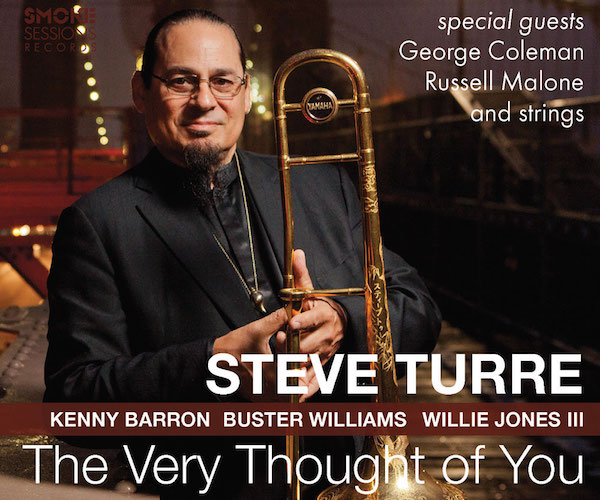Jazz CD Review: Steve Turre — “The Very Thought of You”
The venerable trombonist’s fine new album mostly contains ballads and features an all-star rhythm section.
Steve Turre, The Very Thought of You (Smoke Sessions Records)
 By Michael Ullman
By Michael Ullman
In 1987, trombonist Steve Turre, who became known to jazz fans in the mid-’70s as a sideman to Roland Kirk, Art Blakey, Woody Shaw, and Chico Hamilton, made a record called Viewpoint, on which he paid tribute to his influences and teachers. It’s an eclectic group. “Who’s Kiddin?” is dedicated to tail gate trombonist Kid Ory, who first recorded his “Ory’s Creole Trombone” in 1922. (The most famous version of the tune was made five years later with Louis Armstrong.) Turre says he learned wah-wah trombone from a master, Quentin Jackson, who demonstrated his skill with Ellington. So he plays “In a Sentimental Mood.” He also pays tribute to the great bebop player J.J. Johnson with Johnson’s “Lament,” to Miles Davis (with “All Blues”), and to salsa music. The album is a mini-history of the jazz trombone and its evolving technique, from the swooping use of the slide in Kid Ory and the fast, clean playing of Johnson to the renewed brashness of salsa and of free jazz.
Turre isn’t as inclusive on his new, mostly ballads album, The Very Thought of You. It features an all-star rhythm section of Kenny Barron, Buster Williams and Willie Jones, with guest appearances by saxophonist George Coleman and guitarist Russell Malone. On four cuts, Turre plays in front of an octet of string players — all Juilliard students! — in arrangements by Marty Sheller. The strings first appear on the title cut, but are most effective in the gently swaying “Shadow of Your Smile,” where Turre’s sweetly muted trombone sounds like a singer. He’s subtle rhythmically, varies his tone with a hint of a growl on some low points, and gracefully yields to Russell Malone, who bends notes, rushes ahead, and then settles down to the beat, all in a single chorus.
On Charlie Parker’s “Yardbird Suite,” Turre begins the first A section over drums and in unison with bassist Williams. Then, in a neatly varied arrangement, saxophonist Coleman and pianist Barron play the second A section before the entire band enters. It’s simple, and yet expressive in its subtle variety. The first solo is by the saxophonist. Coleman then takes off in a flurry, as if the arrangement were holding him down. Barron follows, and is as adept and inventive as usual.

Steve Turre. Photo: courtesy of the artist.
The other bebop tune is J.J. Johnson’s “Carolyn in the Morning,” from the composer’s Heroes album. Johnson’s wife is the Carolyn of the title: she’s also the inspiration for Johnson’s “Carolyn in the Evening,” not performed here. In the morning, Carolyn is peaceful — almost to the point of torpor. The rhythm section saves this track: Williams provides quick runs in the background and Jones snaps his brushes. Malone is equally appealing as a soloist.
If there is a flaw in this fine recording, it is the imbalance on the duet “No Regrets” between Turre and Malone. It’s possible for these instruments to play together successfully … I am thinking of Bob Brookmeyer with Jim Hall. Here, though, Malone seems to be trapped in the background; he sounds as if he is practicing while Turre imperturbably plays the ballad. Turre’s exercise in free jazz, “Freedom Park,” is a more even-handed excursion: it’s a duet between the trombonist and drummer Willie Jones. The disc ends with a marvelous version of a sentimental standby: Turre, Malone, and strings play”Danny Boy.” The trombonist performs with a plunger, and he makes his instrument talk, exquisitely. It’s hard not to sing along. This is one to put beside the recorded versions from Ben Webster (there are at least two) and Bill Evans.
Michael Ullman studied classical clarinet and was educated at Harvard, the University of Chicago, and the U. of Michigan, from which he received a PhD in English. The author or co-author of two books on jazz, he has written on jazz and classical music for The Atlantic Monthly, The New Republic, High Fidelity, Stereophile, The Boston Phoenix, The Boston Globe, and other venues. His articles on Dickens, Joyce, Kipling, and others have appeared in academic journals. For over 20 years, he has written a bi-monthly jazz column for Fanfare Magazine, for which he also reviews classical music. At Tufts University, he teaches mostly modernist writers in the English Department and jazz and blues history in the Music Department. (He plays piano badly.)
